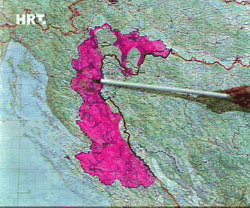Croatian Offensive on Knin, Operation "Oluja"
 Before the war, 12% of Croatian citizens were of Serbian nationality. Half of
them lived in the region called Krajina. Krajina, which literally means
"zone", was created by Austrians in 16th century as a military zone to protect
the Christian West from the advance of Muslim Ottoman Empire. Serbian peasants
that escaped Ottoman rule were given free land there in exchange for their
military service. After the collapse of both empires, Serbs, which remained
living in Krajina, continued to hold jobs in police, military and security
services throughout both the Kingdom of Yugoslavia and the late Yugoslav
communist state.
Before the war, 12% of Croatian citizens were of Serbian nationality. Half of
them lived in the region called Krajina. Krajina, which literally means
"zone", was created by Austrians in 16th century as a military zone to protect
the Christian West from the advance of Muslim Ottoman Empire. Serbian peasants
that escaped Ottoman rule were given free land there in exchange for their
military service. After the collapse of both empires, Serbs, which remained
living in Krajina, continued to hold jobs in police, military and security
services throughout both the Kingdom of Yugoslavia and the late Yugoslav
communist state.
In 1991, instigated by propaganda spread by agents of Serbian president Slobodan
Milosevic and provoked by use of symbols related to Croatian Nazi regime in
Franjo Tudjman's presidential race, they rebelled against Croatian independence,
and cut themselves of from Croatian state, thus depriving Croatia of roughly 1/3
of its territory. Quickly, Serbs proclaimed their own independent state:
Republika Srpska Krajina with a capital in Knin (an important railroad junction
in former Yugoslavia). In six months in 1991 and 1992, RSK insurgents, helped and
armed by Yugoslav Army, cleansed the Krajina region of Croats, burned dozens of
villages, destroyed hundreds of Catholic churches, created thousands of refugees, shelled
Croatian coastal cities like Sibenik, Zadar and Dubrovnik and levelled to the
ground city of Vukovar in Eastern Slavonia. After the peace agreement brokered
by the European Community, the stand-off lasted until this August (1995), when
Croatian Army reclaimed most of the territory in just three days, setting 120,000
Serbs on the run - about a half of all Serbs that left Croatia due to the war. Before the 800,000 refugees of the Kosovo war in 1999 this was the largest single episode of "population displacement" in the wars of Yugoslav succession. There is a heated argument between Serbs and Croats about whether this even actually constitutes 'ethnic cleansing.' Serbs, indeed, left under orders of their leaders, but those leaders issued those orders under the looming threat of Croatian military offensive. General Ratko Mladic became well known for his saying that he 'had allowed inhabitants of Srebrenica to leave.' Unlike Serbs from Krajina, they did not listen... Croat authorities fully co-operated with Serb exodus, facilitating Serb passage to Republika Srpska and Serbia proper. The flight was so well orchestrated, that they even had a US ambassador to Croatia at the helm. Still, there were incidents (for which a number of Croatian military personnel is asked to answer the ICTY charges). You be the judge.
Here you can graphically see both views of the operation "Oluja" (storm):
Croatian point of view
Serbian point of
view
back
 Before the war, 12% of Croatian citizens were of Serbian nationality. Half of
them lived in the region called Krajina. Krajina, which literally means
"zone", was created by Austrians in 16th century as a military zone to protect
the Christian West from the advance of Muslim Ottoman Empire. Serbian peasants
that escaped Ottoman rule were given free land there in exchange for their
military service. After the collapse of both empires, Serbs, which remained
living in Krajina, continued to hold jobs in police, military and security
services throughout both the Kingdom of Yugoslavia and the late Yugoslav
communist state.
Before the war, 12% of Croatian citizens were of Serbian nationality. Half of
them lived in the region called Krajina. Krajina, which literally means
"zone", was created by Austrians in 16th century as a military zone to protect
the Christian West from the advance of Muslim Ottoman Empire. Serbian peasants
that escaped Ottoman rule were given free land there in exchange for their
military service. After the collapse of both empires, Serbs, which remained
living in Krajina, continued to hold jobs in police, military and security
services throughout both the Kingdom of Yugoslavia and the late Yugoslav
communist state.